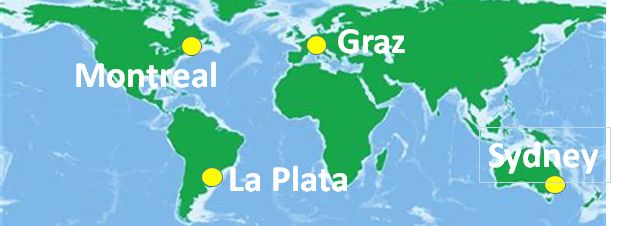How can we make academic conferences more global, inclusive, accessible, culturally diverse, and environmentally friendly, while at the same time improving electronic documentation? Internet-based communication technologies can be used to reduce both carbon emissions and financial costs of academic conferences for individual participants—especially those from non-rich countries—while maintaining a dynamic, face-to-face, personal feel.
In July 2018, the Centre for Systematic Musicology organized the leading international conference on music cognition (ICMPC15/ESCOM10) as a multiple-location, semi-virtual event with hubs on four continents (Europe, North America, South America, Australia) and 600 active participants. During parallel sessions, participants chose between simultaneous live (local) and virtual (remote) presentations. Every talk was live-streamed to YouTube (“unlisted” with URLs accessible only to registered participants) and seen by two audiences (local and remote). Remote presentations were either real-time or delayed. Discussions were two-way audiovisual (Zoom).
The 24-hour program ran for five days, with normal working hours at each hub. Most (61%) participants approved of the semi-virtual format. Many colleagues included who could not otherwise have afforded the trip (especially those from South America). Thanks to support from qualified technical assistants (mostly audio engineering students), no talk was delayed or canceled for technical reasons. Greenhouse-gas emissions per participant were reduced by 60-70% relative to an equivalent single-location conference. In future, emissions and international time-difference problems can be further reduced by adding more hubs.
Climate change is an existential threat to humanity and hence to all academic research in all disciplines. If people in rich countries (including academic researchers) do not significantly reduce their emissions in coming years, approaching zero in coming decades, an unprecedented global catastrophe is inevitable. The contribution of aviation to global CO2 is 3% and rising 5% per year; the warming effect (radiative forcing) is more than twice that of CO2 due to other gases and interactions. Unlike other sectors, no reasonable technological alternative is available. The problem must be solved now and not in 20 years. Neither silence nor panic will help. We urgently need to implement rational solutions that significantly reduce individual carbon footprints. In academia, than inevitably means reducing flying.
A semi-virtual, multiple-location approach to academic conferences can cut emissions (approaching zero if no-one flies) while at the same time improving globality, cultural diversity, and accessibility. That in turn improves the relevance and long-term quality of academic content. Every academic conference, regardless of size, discipline, or country, can benefit from live-streaming some or all presentations. Academics and conference organizers can contribute to global mitigation efforts while at the same time taking advantage of modern internet communication technologies to promote their academic disciplines and. Video recordings of talks contribute to documentation and dissemination.
The talk is for 30 minutes, followed by 30 minutes for plenary discussion and 30 minutes for smaller groups.
